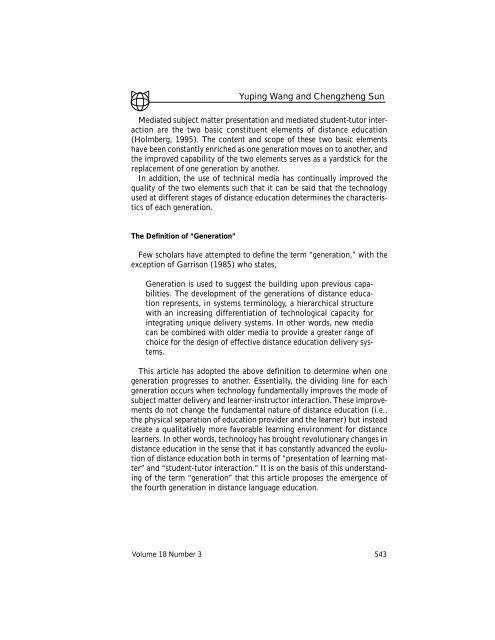Download this PDF file - Software @ SFU Library
Download this PDF file - Software @ SFU Library
Download this PDF file - Software @ SFU Library
You also want an ePaper? Increase the reach of your titles
YUMPU automatically turns print PDFs into web optimized ePapers that Google loves.
Yuping Wang and Chengzheng Sun<br />
Mediated subject matter presentation and mediated student-tutor interaction<br />
are the two basic constituent elements of distance education<br />
(Holmberg, 1995). The content and scope of these two basic elements<br />
have been constantly enriched as one generation moves on to another, and<br />
the improved capability of the two elements serves as a yardstick for the<br />
replacement of one generation by another.<br />
In addition, the use of technical media has continually improved the<br />
quality of the two elements such that it can be said that the technology<br />
used at different stages of distance education determines the characteristics<br />
of each generation.<br />
The Definition of “Generation”<br />
Few scholars have attempted to define the term “generation,” with the<br />
exception of Garrison (1985) who states,<br />
Generation is used to suggest the building upon previous capabilities.<br />
The development of the generations of distance education<br />
represents, in systems terminology, a hierarchical structure<br />
with an increasing differentiation of technological capacity for<br />
integrating unique delivery systems. In other words, new media<br />
can be combined with older media to provide a greater range of<br />
choice for the design of effective distance education delivery systems.<br />
This article has adopted the above definition to determine when one<br />
generation progresses to another. Essentially, the dividing line for each<br />
generation occurs when technology fundamentally improves the mode of<br />
subject matter delivery and learner-instructor interaction. These improvements<br />
do not change the fundamental nature of distance education (i.e.,<br />
the physical separation of education provider and the learner) but instead<br />
create a qualitatively more favorable learning environment for distance<br />
learners. In other words, technology has brought revolutionary changes in<br />
distance education in the sense that it has constantly advanced the evolution<br />
of distance education both in terms of “presentation of learning matter”<br />
and “student-tutor interaction.” It is on the basis of <strong>this</strong> understanding<br />
of the term “generation” that <strong>this</strong> article proposes the emergence of<br />
the fourth generation in distance language education.<br />
Volume 18 Number 3 543
















